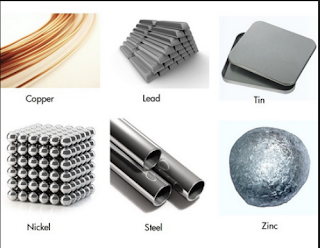METAL - DEFINITION
- There are about 118 chemical elements known at present. On the basis of their properties, all the elements can be divided into two main groups : metals and non-metals.
 |
| Metals example |
METAL :
- Metals are the element which form positive ions ( Cations ) by losing valance electrons. For example, aluminum (Al) is a metal which forms positively charged aluminum ions (Al3+) by losing electrons.
- Metal are the elements which are malleable, ductile, lustrous (shiny), hard, strong, heavy, sonorous, conductor of heat and electricity and have high melting and boiling point.
PHYSICAL PROPERTIES OF METALS :
The important physical properties of metals are given below.
Physical State:
- All metals are solid at room temperature.
- Mercury is Liquid at room temperature.
- Gallium is changed into liquid when handled.
- Metals can be beaten into thin sheets without cracking . this property of metals is called malleability.
- Gold and silver metals are best malleable.
Exception : Zinc and Mercury are not Malleable
Ductility:
- Metals can be drawn or stretched into thin wires. this property of metals is called ductility.
- Gold,silver , copper, aluminium are the most ductile metals in that order . For example, just 1 gram of gold can be drawn into a thin wire about 2 kilometres long.
Conductor of heat :
- Metals are good conductor of heat.
- Silver metal is the best conductor of heat. Copper and aluminium metals are also very good conductors of heat.
- The cooking utensils and water boilers, etc., are usually made of copper or aluminium metals because they are very good conductors of heat.
- The poorest conductor of heat among the metals is lead and Mercury .
Conductor of electricity:
- Metals are good conductors of electricity.
- Silver metal is the best conductor of electricity.
- Copper metal is the next best conductor of electricity followed by gold, aluminium and tungsten.
- The electric wires are made of copper and aluminium metals because they are very good conductors of electricity.
Metals are lustrous (or shiny) :
- Metals are lustrous, i.e they have a shining surface.The property of a metal of having a shining surface is called 'metallic lustre'.
- Exception :Lead is not Lustrous.
Hardness :
- Most of the metals are hard. But all the metals are not equally hard. The hardness varies from metal to metal.
- Sodium and potassium are soft metals which can be easily cut with a knife.
Metals are solids at room temperature :
- Metals are solid at room temperature
- Only one metal, mercury, is liquid state at the room temperature.
Melting points and Boiling points:
- Generally Metals have high melting and boiling point.
- sodium , potassium metals have low melting and boiling points.
Densitiy:
- Metals have high densities except sodium and potassium i.e metals are heavy substances. For example, the density of iron is 7.8 g/cm3 which is quite high So, iron metal is a heavy substance.
Sonority
- Sonorous means capable of producing a deep or ringing sound.
- Metals make sound when hit with an object.This property of Metal is called Sonority.
- It is due to the property of sonorousness (or sonority) that metals are used for making bells, and strings (wires) of musical instruments like sitar and violin
Colour :
- Metals usually have a silver or grey colour except copper and gold.
- Copper has a reddish-brown colour whereas gold has yellow colour.
USES OF METALS
Metals are used for a large number of purposes. Some of the uses of metals are given below :
- Copper and aluminium metals are used to make wires to carry electric current. This is because copper and aluminium have very low electrical resistance and hence very good conductors of electricity
- Iron, copper and aluminium metals are used to make house-hold utensils.
- Iron is used as catalyst in the preparation of ammonia gas by Haber's process.
- Zinc is used for galvanizing iron to protect it from rusting
- Chromium and nickel metals are used for electroplating and in the manufacture of stainless steel.
- The aluminium foils are used in packaging of medicines, cigarettes and food materials be basic in xide is basic
- Silver and gold metals are used to make jewellery. The thin foils made of silver and gold are used to decorate sweets.
- The liquid metal 'mercury' is used in making thermometers
- Sodium, titanium and zirconium metals are used in atomic energy (nuclear energy) and space science projects
- Zirconium metal is used in making bullet-proof alloy steels
- Lead metal is used in making car batteries.

No comments:
Post a Comment